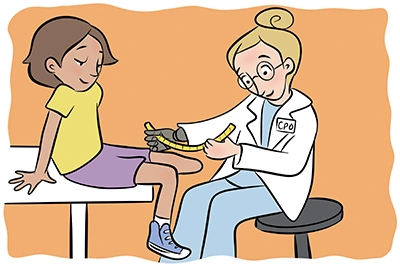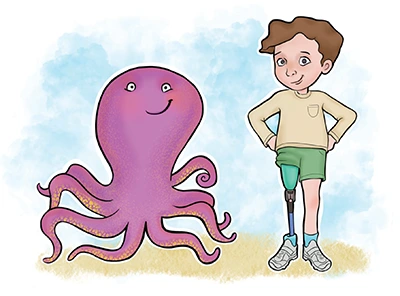
“I’ve been drawing ever since I can remember,” says illustrator Jennifer Latham Robinson. But as a child with an above-knee amputation caused by proximal femoral focal deficiency, or PFFD, she never saw people with limb difference portrayed in books or cartoons—so she drew them herself.
“I was always struck by the lack of representation, even when I was very young,” Robinson recalls. “My earliest drawings were about limb difference. And my senior college thesis was about the depiction of disabled bodies in children’s literature. It’s been kind of a lifelong journey.”
Robinson’s latest project is a new creative outlet for today’s budding amputee artists. Titled Limb Horizons, the project aims to develop illustrated children’s stories that educate families about limb difference, prosthetics, and orthotics. Some of the source material will come from limb-different children themselves: Limb Horizons will provide a platform where kids can share their writings and drawings with each other.
“The goal is to present information in a way that’s fun and empowering for kids,” says Robinson. “I was in my 20s before I really understood my own anatomy and how my prosthetics worked. I didn’t have any of the terminology, and you need to know this stuff to be a smart consumer.”
Robinson knows children and parents are hungry for this type of information. She has seen it routinely over many years as a patient programming specialist in O&P clinics, shepherding individual families through the learning curve. One goal of Limb Horizons is to give people the vocabulary they need in an accessible, kid-friendly format.

Another goal, Robinson says, is to let kids learn through self-expression. “Drawing helped me understand my own body growing up,” she explains. “It was almost like memorizing my own body, because I never saw it represented anywhere. [Limb Horizons] can be a confidence booster for kids who like to draw. And it can help other kids experiencing limb difference to see how their peers portray themselves. It just opens your mind to different experiences and promotes acceptance. And it’s a better way to connect, in my opinion, than going on Instagram or TikTok.”
Robinson has authored three books and one coloring book for amputee children, and her illustrations are available for download at Limb Horizons. But this project is less about showcasing her art and more about giving today’s youth an opportunity to share their talent.
“I felt that yearning when I was a young artist,” she says. “I wanted my art out there, and I wanted to see people who looked like me. So I’m really excited to get this project going.”
To check out the online gallery or submit your or your child’s art, visit Limb Horizons at limbhorizons.com.




